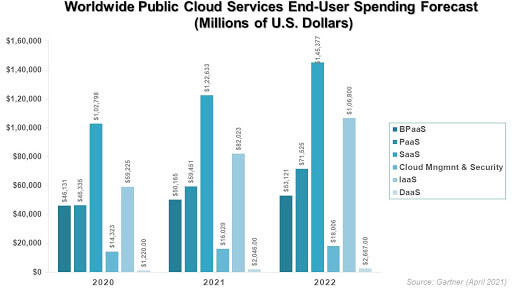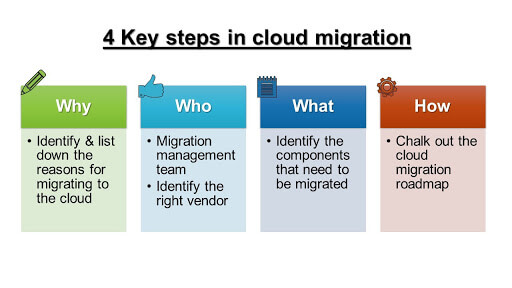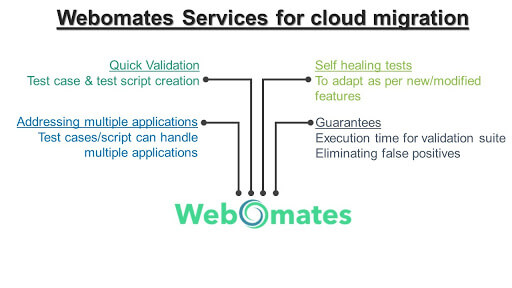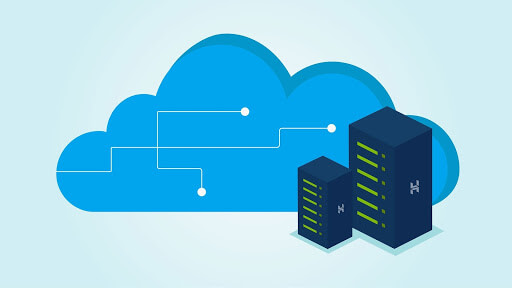Accelerate Success with AI-Powered Test Automation – Smarter, Faster, Flawless
Start free trialCloud Migration is the process of moving different business elements, like data, processes, services, and applications from on-premise setup to cloud setup. It aids the organizations in being more efficient by optimizing the infrastructure and providing better customer services.
Expenditures and budgets earmarked globally for cloud adoption have seen an upward trend over the past few years. The year 2020 was an accelerant in increased cloud footprint due to the global pandemic.
As per the Gartner survey conducted in April 2021, millions of US Dollars are expected to be spent by organizations worldwide on cloud services.

Steps in Cloud Migration
Before embarking on the cloud migration journey, it is imperative to understand all possible roadblocks one may encounter and how to overcome them. You can read about those in detail in our blog “Top 5 Challenges in cloud migration”.
It is always a good idea to have a detailed roadmap in place for a successful migration process. This article talks about the key steps involved in cloud migration, addressing 4 major questions – Why, Who, What, and How.

Why should You Move to The Cloud?
Start by listing down the reasons for making the move, keeping in mind the business goals and what value cloud migration will add to the business. Analysis and introspection further help in formulating a solid migration plan.
- How will the migration help in cutting down IT expenditures?
- Will moving to the cloud help in leveraging new technologies, thus accelerating growth?
- Does the move help in improving performance and enhance security for processes and operations?
- What effect will it have on overall business and workforce?
- What are the infrastructural requirements of current business and projected requirements for the future?
- Will the transition affect operational continuity?
Once the answers to these questions are in place, it is time to move on to the next level.
Who should be Involved in Migration – People and Enterprises
It is important to have a task team of experts – Migration architect, Subject matter expert, IT analyst, business analyst, vendor liaison, and manager. This team will be responsible for planning, executing, and monitoring the cloud migration process. Once the plan is in place, it should be communicated to all the stakeholders – technical and business.
The next step is to identify the right vendor based on the requirements identified by the migration team. Certain factors should be considered while choosing the vendor to maximize the benefits, like:
- Business footprint of the service provider
- Compliance with industry best practices and standards
- Reliability and credibility
- Security – for applications, process, and data
- Architecture
- Contracts, Service level agreement, exit clause to prevent lock-ins
- Pricing models
- Service and technical support
What should be Migrated?
Not all applications and processes may be cloud-ready. Depending on the service provider’s infrastructure, some applications/processes may need minor changes or a complete revamp. It is vital to conduct a detailed analysis of what should be migrated to the cloud without affecting the operations. Conducting the following exercises to shortlist the components helps in formulating a robust strategy.
- Map all application dependencies: Prepare an application dependency map and list down the components that can be moved independently and what all need to be moved together as a block.
- Prioritize the components: Prioritize the component migration based on the complexity and services affected by the component to be moved. A dependency map comes in handy in making these decisions.
- Validate each step: It is important to validate every step of the migration to ensure that the end-user services are not disrupted. Webomates has capabilities to help organizations in having glitch-free migration. Details about Webomates services about cloud migration have been discussed in detail in the entailing section.
- Define data migration strategy: Data migration can prove to be tricky. Data has to stay in sync with all the components, whether on-premise or already migrated. As a fallback plan, take a complete data backup before migration. Testing after each step of data migration also helps.

How to Migrate – The Roadmap
- Choose the level of cloud integration
Deep (Re-architect): Sometimes, it becomes necessary to modify legacy applications to take maximum advantage of the cloud capabilities. In such scenarios, redesigning and coding the major components to align with the cloud needs to be done.
Shallow (Lift-and-shift or re-host): Organizations may choose to migrate their process/application as is or with minor tweaks in case their application is not dependent on specific cloud services.
- Choose the cloud model
Identify a suitable cloud model depending on the nature of the business and application. It could be either of these,
- Single
- Multi-clouds
- Hybrid (part cloud, part on-premise)
- Establish Key Performance Indicators
Establishing baseline KPI’s aids in measuring how the migration has helped in enhancing overall performance. Common KPI’s that need to be considered are
- Infrastructure cost benefits
- Better user experience
- Performance improvement
- Enhanced Security
- Business benefits(Pre-migration performance vis-à-vis Post-Migration)
Tracking and monitoring the pre-migration and post-migration performance and comparing them with baselines is immensely useful in measuring the success of migration and detecting issues if any.
How Webomates can Help You in a Glitch-Free Cloud Migration
Moving to the cloud is not difficult if done correctly by defining and following a proper cloud migration strategy. As mentioned above, it is extremely important to ensure that all cogwheels keep moving for an uninterrupted end-user experience. We at Webomates help organizations in realizing this dream by validating every step of migration.

Webomates CQ provides testing as a service(TaaS) that leverages test automation supplemented with AI capabilities to generate test cases that span multiple applications. Test case generation can be done within a matter of weeks. This saves a significant amount of customer’s time and efforts.
There is also a provision for rapid ramp up and ramp down of test cases as per the need.
We also provide service level guarantees for validation test suite execution. Our AI Defect Predictor ensures that no false positives are reported.
There might be scenarios when development is underway while a component is being migrated. Our validation suite intelligently adapts to incorporate the new/modified features and healed validation suites are executed and validated. This aids in maintaining the integrity of the application.
We have helped one of our prestigious clients in migrating to the cloud seamlessly saving thousands of man-hours.
We have helped one of our prestigious clients in migrating their operations to the cloud seamlessly saving thousands of man-hours. Read more about it by clicking here.
Partner with us for effortless cloud migration. Click here to schedule a demo, or reach out to us at info@webomates.com
Tags: AWS, Cloud migration, Cloud testing

Leave a Reply